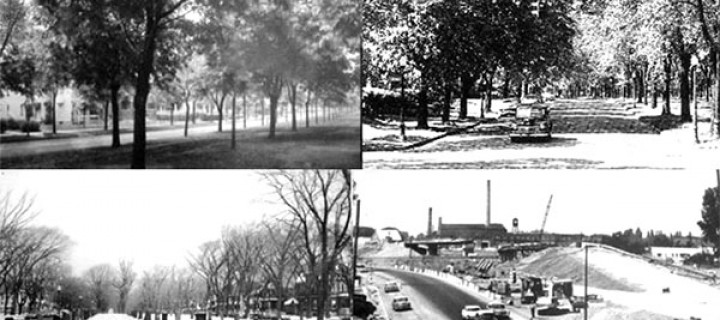“Update on a Restored Humboldt Parkway: “The Green Parkway””
Below article was published in The Challenger, Aug 3, 2014.
Update on a Restored Humboldt Parkway: “The Green Parkway”

“Because of the persistence of neighbors and institutions around Humboldt Parkway, the dream of a “Green Parkway” to restore the community is coming into clearer vision. A new University at Buffalo report has been released, which documents the economic impact of a restored Humboldt Parkway. In a study commissioned by the New York State Department of Transportation, the UB School of Architecture and Planning in conjunction with its Regional Institute Urban Design Project, a team of experts led by principal investigator, Robert Shibley, has ascertained that such a project would have a minimal regional economic impact exceeding $1 Billion and construction employment of hundreds of jobs. In the best case scenario, the impact would catalyze the complete revitalization of an area from the Fillmore Business District to the Jefferson Street Business District and the residential neighborhoods in between. Such revitalization would spur new mixed-use development, improving property values and household wealth.
The Restore Our Community Coalition (ROCC) shared highlights of the UB report with the general public last Tuesday at the Buffalo Museum of Science. The target audience was residents of Hamlin Park, known as the Hamlin Park Taxpayers Association, and block club advocates from Humboldt Parkway, East Ferry, and Delevan Streets, as well as owners of neighborhood businesses from Fillmore to Jefferson. The meeting was open to the public.
ROCC chairperson Stephanie Geter stated, “We want to update the community on the progress toward reaching our goal to restore the Olmsted vision of a vibrant, green community space, to remediate the devastation caused by the construction of Route 33, and to create a beautiful gateway to Buffalo’s Medical Corridor. ROCC came together in 2007 to bring this issue to the attention of local and state leaders, focusing our coalition power on the New York State Department of Transportation. Much work has been going on behind the scenes, and we have a plan to make this vision a reality.”
Indeed, the vision is not a new one. In the 1870’s, Frederick Law Olmsted articulated a vision of a “city within a park” that became the nation’s first interconnected park system. A major corridor in the system was Humboldt Parkway connecting Delaware Park with the former “Parade,” later renamed Humboldt Park, and now called Dr. Martin Luther King, Jr. Park. Olmsted Parks Conservancy President Thomas Herrera-Mishler noted that Humboldt Parkway was designed to allow users to travel from one park to another without leaving the serenity of the park-like atmosphere. He said, “six rows of mature shade trees once provided a wonderful canopy not only to connect Olmsted’s Delaware and Parade Parks, but also to provide a valuable green space where everyone was welcome to enjoy nature, enhancing the visual character and quality of life for the whole community. Restoring this green anchor on the East Side of Buffalo is a major priority of the Conservancy.”
Richard Cummings, President of the Black Chamber of Commerce, asserts that “while the Kensington Expressway construction led to community devastation, we are optimistic that some of the damage can be reversed. Even though the introduction of the expressway in the 60’s isolated the East Side from the rest of Buffalo, initiating a period of disinvestment and neighborhood decline, we are working with businesses, residents and city leaders to reverse that decline. We believe that our community can be restored.”
The Humboldt community includes neighbors, business owners, cultural institutions and tourist attractions. “We absolutely embrace the vision to re-create a viable, walkable, green environment on all sides of the Museum”, Says Mark Mortenson of the Buffalo Museum of Science. “That is the environment that the Museum celebrated until it was tragically lost by the construction of the Kensington Expressway.”
The idea to cover a portion of Route 33 may have seemed farfetched to many local residents and even elected officials and transportation leaders, but the reality is that there is a movement across America to remove urban freeway systems in order to create more livable cities. “Highways to Boulevards” is a major initiative of the Congress for New Urbanism (CNU), which came to Buffalo for its 22nd Annual Congress this past June. The 4 day conference was themed “The Resilient Community,” and several sessions addressed issues related to the restoration of the Humboldt Parkway community.
Conference attendee Karen Stanley Fleming, who serves as the Executive Director for ROCC, stated, “ I was elated to meet several leading planners and urbanism experts who affirmed the human, economic and environmental benefits of sustainable planning projects such as our proposal to create a green deck over a portion of Route 33. Projects like this are going on around the country, and at even greater expense that the projected $560 million that a Green Humboldt Deck would cost, because the point is that this in an investment, which will reap returns. It is not just a transportation cost to correct an urban sprawl mistake. An investment to turn part of this highway into a green boulevard will reap dividends in terms of job creation and increased property values. An invest terms of job creation and increased property values. An investment to restore a Green Humboldt Parkway will bring to our Buffalo Renaissance the beautiful gateway that our Downtown Revitalization deserves.””
Download a pdf of this article, here.
